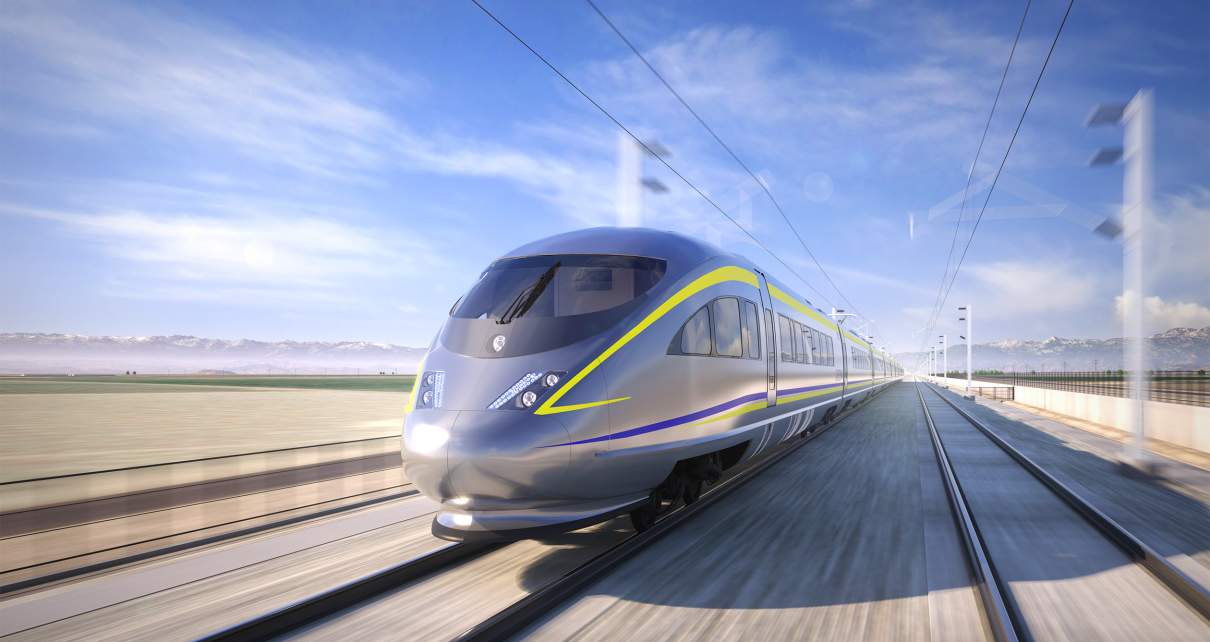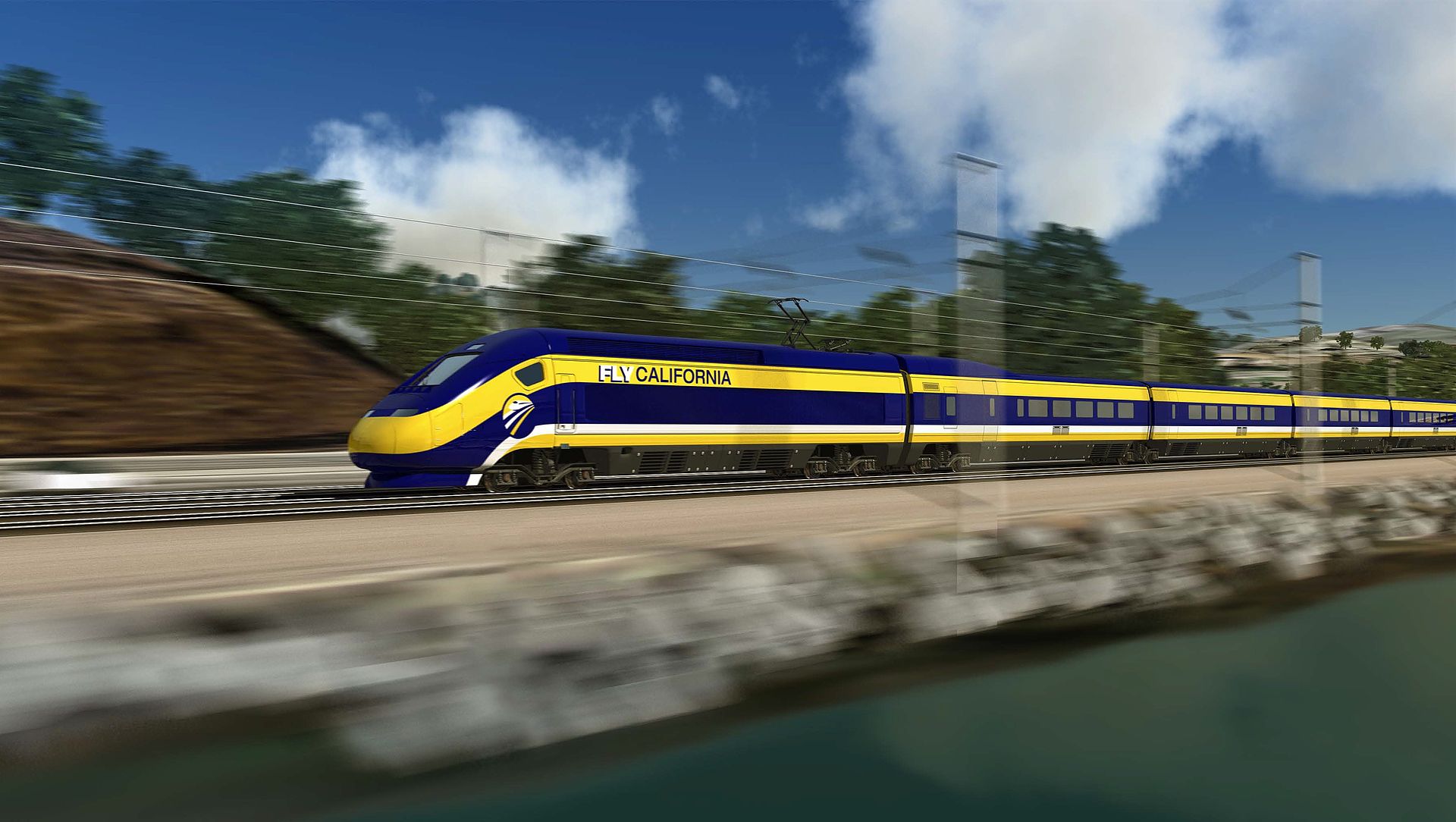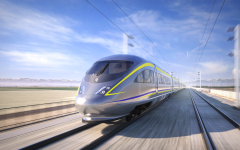
California high speed rail proposed train (Photo: hsr.ca.gov)
California High-Speed Rail Needs $7 Billion for Bakersfield to Merced by 2026
‘As the voters passed it in 2008, it’s never going to happen’
By Evan Symon, March 27, 2025 2:45 am
The California Legislative Analyst’s Office told lawmakers in an Assembly Transportation budget hearing Wednesday that California High-Speed Rail needs $7 billion in funding by June 2026 or else the first Bakersfield to Merced leg of the system could be delayed further into the 2030’s.
According to LAO Principal Fiscal & Policy Analyst Helen Kerstein, who delivered the $7 billion shortfall figure to the Assembly, that amount isn’t guaranteed either. She warned that they may need more than that amount in funding to shore up the gap, especially with $4 billion in federal funding for the project now on the line in Washington.
“There is no specific plan to meet that roughly $7 billion gap, we also think there is some risk that gap could grow,” said Kerstein. “This isn’t a way out in the future funding gap. This is a pretty immediate funding gap.”
While the hearing was expected to be fairly long on Wednesday, the High-Speed Rail Authority (CHRSA) did not submit a complete project update for lawmakers to review, leading to a shortened meeting.
“We are diligently working to get that information respect to scope, schedule, ridership,” expressed CHRSA Chief of Staff Michael Tollefson.
However, the LAO did come prepared, giving the $7 billion funding gap figure, distressing many lawmakers at the meeting. While the High-Speed Rail Authority did say that a project update would come this summer, it did little to quell legislators from both sides of the aisle.
“We have no plan, we have a good likelihood it’s going to get worse, and we have a short time to solve the problem,” explained Assemblyman Steven Bennett (D-Ventura). “That’s not a good place for government to put itself into.”
“The timing of the project review seems totally out of whack with when we need to be making decisions,” added Assemblywoman Cottie Petrie-Norris (D-Irvine). “The definition of insanity is doing the same thing over and over again and expecting a different outcome.”
“It’s beyond disappointing how this project has been managed”, said Assemblyman Tom Lackey (R-Palmdale) to the Globe on Thursday. “How can the Governor and the supermajority democrats continue to fund this project while so many other critical priorities in the State Budget go underfunded?”
A new $7 billion shortfall

“I was in middle school when this happened,” Assemblywoman Alexandra Macedo (R-Tulare) said in a statement. “We don’t have the time, we don’t have the money, we just need to pull the plug on this project. As the voters passed it in 2008, it’s never going to happen.”
Originally estimated to cost $33 billion in 2008 with a San Francisco to Los Angeles line to open by 2028, the California high speed rail system has since ballooned to $128 billion, and $135 billion+, with an estimated partial completion somewhere in the late 2030’s. And last year, CHRSA actually confirmed that the system still needed $100 billion to link up San Francisco and Los Angeles. The true cost may also be much higher than anticipated, with some estimates during the Governorship of Jerry Brown putting that figure at around $350 billion.
President Trump announced last month that he would be launching an investigation into CHSRA, fulfilling a promise his administration made to look into the system. Specifically, he noted that the high cost of the program was mind-boggling, echoing decades of criticisms within California that the project has been nothing more than a boondoggle. That promise came true a few weeks later, with Transportation Secretary Sean Duffy announcing a compliance review of funding for the California High-Speed Rail Authority, with $4 billion of federal funding currently at stake for California. The $7 billion shortfall announcement on Wednesday only worsens the prospects for the project, with both a longer delay and even higher costs likely to come as a result.
Nonetheless, Governor Gavin Newsom has remained adamant that the project continue. In January, he helped lay down the first piece of rail in Kern County, and earlier on Wednesday, defended the high-speed rail project on his podcast This is Gavin Newsom. During the episode with New York Times columnist Ezra Klein, Newsom said that the “hard part” was behind them and deflected questions from Klein over the ballooned cost of the rail system.
“We did the rail head, we’re starting to lay track. This thing is starting to get very, very real,” noted Newsom. “There were challenges, but now the hard work is behind us, and now we’re laying track. At the end of the day, we’ve got these constraints that are well established and existing constraints. There’s not a high-speed rail system that doesn’t have some popularity and success, most are wildly popular, it’s an experience no one has had in the United States of America, at least we’re out there daring.”
The podcast episode, recorded several days earlier, did not deal with the $7 billion funding gap announcement. As of Wednesday evening, Newsom has yet to address the latest setback for high-speed rail.
- Bill to Require Law Enforcement Disclosure if AI Was Used To Help Write Reports - August 7, 2025
- Gov. Newsom Files FOIA Request To ‘Expose True Cost’ Of L.A. Federal Troop Deployment for Anti-ICE Riots - August 6, 2025
- California Redistricting: How Newsom’s Plan Will Demolish Hard Fought GOP Gains - August 6, 2025





No. Absolutely not. This has now become the most embarrassing project in our national history. The supermajority makes a joke out of itself through continued funding of this boondoggle.
The level of graft on just this one project is astounding… Now apply/multiply that to hundreds of other projects around the country over the last 50+ years….
If and I mean If, HSR had been built in the I-5 Median it would be in service by now. It’s now a very bad joke, let’s cut our losses and end it now!
I concur. The I-5 median alignment was recommended in a peer review made by other high-speed rail authorities and systems from around the world. It makes sense given Caltrans already owns the right-of-way and it would limit the use of Eminent Domain. Had the CAHSRA chosen that alignment, it the system would most likely be in operation and meet the run times promised in the 2008 proposition.
Republican Assemblywoman Alexandra Macedo showed common sense that the Newsom and the Democrat supermajority lack with her comment: “I was in middle school when this happened. We don’t have the time, we don’t have the money, we just need to pull the plug on this project. As the voters passed it in 2008, it’s never going to happen.”
Nope. Not gonna happen. Start dismantling this fiasco by giving farmers back their land.
For $7 Billion, Caltrans could have widened I-5 between Tracy and the Grapevine from 4 to 6 or 8 lanes. In addition, it would have been better for the State and the San Joaquin Rail Commission to have upgraded the existing Amtrak San Joaquin service, which already runs between Bakersfield and Merced instead of having the CAHSRA build viaducts to nowhere through Fresno.
Maybe when pigs fly. NOPE.
When the BoomrWaffen finally pass away can we end this doozy of a project? Hand this operation over to Brightline if it must be done.
Yes, investigate the whole project because it appears to be little more than a giant kickback machine.
If you include enough high value freight revenue on the HSR consist, then you would not need to ask taxpayers for a dime. The north-south tonnage flows on I-5 & Hwy 99 could be a source of revenue to offset the losses you get moving passengers. Like putting high-end freight in the bellies of the jumbo jets; or mail and bullion next to the shotgun on Wells Fargo stages; or like Railway Express Agency freight and U.S. Mail on passenger trains. We could reduce air pollution and traffic congestion and highway accidents and deaths, reduce commuter times, and reduce road and bridge support repair costs. TOFC & COFC intermodal freight revenue is a superior solution to increase gas taxes. Return to our American roots of free enterprise transportation.
“If you include enough high value freight revenue on the HSR…” But, HSR is only about passengers, not freight. It is a 21st century mass transit, nothing more. Since no freight will be carried and will be managed by a state agency, it won’t really contribute to commerce.
Code Blue!
Pull the plug, it cannot be resuscitated.
Oh but wait for another 7 BILLION DOLLARS (9 zeros), we can lay another mile of track. After all they have state unions and lobbyists to pay out!
Imagine if you live in Redding knowing that your tax dollars are going to something that you would have to take an airplane if you wished to ride? You might as well stay on the plane to your destination.